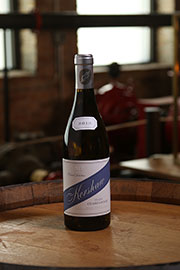- Analysis
- Vineyards
- Vinification and Aging
- Tasting Notes
- 2014 Vintage Notes
Richard Kershaw 2014 Chardonnay
Wine of Origin
Elgin
Varietals
100% Chardonnay made from Dijon Clones CY95, CY96, and CY75
Analysis
Wine Maker: Richard Kershaw
Alcohol: 13.4%
Hand Picking Date: 26th February – 8th March 2014
Brix at Harvest: 22.0 – 22.93
Total Production: 9340 bottles (roughly 775 cases) all individually marked on the label
Elgin is surrounded by mountains, and thus there are distinct delimitations topographically as to where the region starts and finishes. The Elgin Valley is situated on an inland, hexagonal- shaped plateau, at an altitude of 300 meters, surrounded by mountains, only 10km from the Atlantic Ocean.
Within the district of Elgin there are a number of wards and sub-wards that can be identified prior to single vineyard pinpointing. These include areas around the Palmiet River, the areas south towards the southern Kloof, the areas buttressed either side of the N2, and areas to the East and West of Grabouw. Essentially temperatures rarely go above 35°C and generally one wakes up to an agreeably cool day, occasionally swirling in sea-borne mists. Typically, in February, the hottest month of the year, we have cool nights with temperatures dipping to 14°C, a morning of 16°C and beautiful clear days peaking at about 23°C.
The benefit of cooler climates is that the grape cluster stays connected to its roots for longer, developing more characteristics and achieving physiological ripeness more gradually with lower sugar levels and consequently lower alcohols. The resultant wines leave one with an impression of delicacy, but also power and insistence over warmer-climate examples, which show bolder but less-persistent flavors.
Grapes were hand picked in the early autumnal mornings, placed into small lug baskets and tipped directly into a press before being gently whole-bunch pressed up to a maximum of 0.6 bar or until a low juice recovery of 580 liters per ton was obtained. The juice gravity flowed directly to barrel (no pumps were used at all) without settling. The unclarified juice had no enzymes, yeast, or acid added to it and therefore underwent spontaneous fermentation until dry, with malolactic discouraged. The wine rested in barrel for 3 months prior to judicious sulphuring and a further 7 months maturation in barrel before racking, blending, and bottling.
A small number of artisanal coopers were selected, all from Burgundy and only French oak was chosen. 35% of the oak was new with the remainder split into 2nd and 3rd fill barrels of predominantly 228 liters with 10% left to ferment and mature in stainless.
A Restrained, mineral style focussed on elegance with a white fruit character, some oatmeal and complexity were gained from percipient wood application. In 2014, this was interpreted into wines that have focus with understated power, pure fruit expression and incredible concentration of flavor whilst maintaining elegance and semblance of texture that will likely develop exceptionally over the next decade.
An exceptionally wet and cold winter resulted in excellent winter dormancy. Further wet and cold conditions continued late into spring delaying budburst by several weeks. Although disease incidence was higher, the warmer weather that eventually arrived in December enabled the vines to recover. An incredibly wet January kept growers on their toes, but February’s warm, sunny weather allowed veraison to proceed late but under ideal conditions. Th e wet soils meant that growth was put into the shoots rather than the bunches, which despite hindering sugar accumulation, did mean an excellent slow phenolic ripeness made even slower by cooler conditions in early March. This double whammy of slow flavor accrual and preservation of naturally high acidity has meant that 2014 is one of the top Chardonnay vintages of the last decade.

